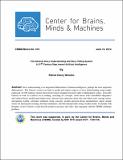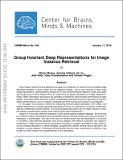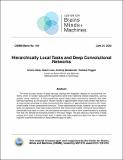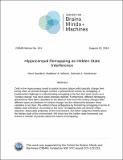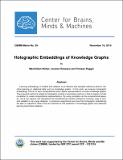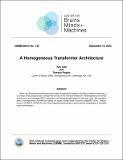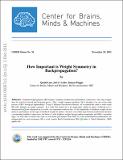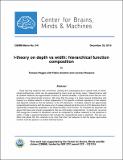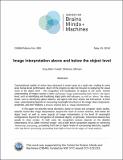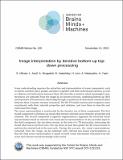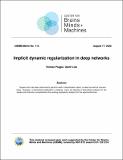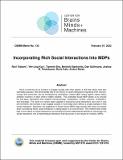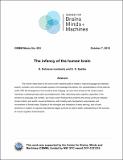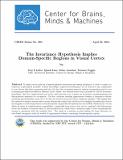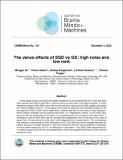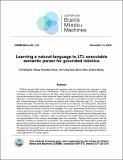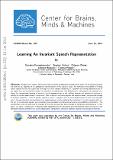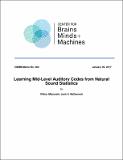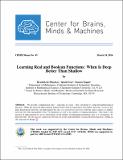Browsing CBMM Memo Series by Title
Now showing items 54-73 of 141
-
The Genesis Story Understanding and Story Telling System A 21st Century Step toward Artificial Intelligence
(Center for Brains, Minds and Machines (CBMM), 2014-06-10)Story understanding is an important differentiator of human intelligence, perhaps the most important differentiator. The Genesis system was built to model and explore aspects of story understanding using simply expressed, ... -
Group Invariant Deep Representations for Image Instance Retrieval
(Center for Brains, Minds and Machines (CBMM), 2016-01-11)Most image instance retrieval pipelines are based on comparison of vectors known as global image descriptors between a query image and the database images. Due to their success in large scale image classification, ... -
Hierarchically Local Tasks and Deep Convolutional Networks
(Center for Brains, Minds and Machines (CBMM), 2020-06-24)The main success stories of deep learning, starting with ImageNet, depend on convolutional networks, which on certain tasks perform significantly better than traditional shallow classifiers, such as support vector machines. ... -
Hippocampal Remapping as Hidden State Inference
(Center for Brains, Minds and Machines (CBMM), bioRxiv, 2019-08-22)Cells in the hippocampus tuned to spatial location (place cells) typically change their tuning when an animal changes context, a phenomenon known as remapping. A fundamental challenge to understanding remapping is the fact ... -
Holographic Embeddings of Knowledge Graphs
(Center for Brains, Minds and Machines (CBMM), arXiv, 2015-11-16)Learning embeddings of entities and relations is an efficient and versatile method to perform machine learning on relational data such as knowledge graphs. In this work, we propose holographic embeddings (HolE) to learn ... -
A Homogeneous Transformer Architecture
(Center for Brains, Minds and Machines (CBMM), 2023-09-18)While the Transformer architecture has made a substantial impact in the field of machine learning, it is unclear what purpose each component serves in the overall architecture. Heterogeneous nonlinear circuits such as ... -
How Important is Weight Symmetry in Backpropagation?
(Center for Brains, Minds and Machines (CBMM), arXiv, 2015-11-29)Gradient backpropagation (BP) requires symmetric feedforward and feedback connections—the same weights must be used for forward and backward passes. This “weight transport problem” [1] is thought to be one of the main ... -
Human-Machine CRFs for Identifying Bottlenecks in Holistic Scene Understanding
(Center for Brains, Minds and Machines (CBMM), arXiv, 2014-06-15)Recent trends in image understanding have pushed for holistic scene understanding models that jointly reason about various tasks such as object detection, scene recognition, shape analysis, contextual reasoning, and local ... -
I-theory on depth vs width: hierarchical function composition
(Center for Brains, Minds and Machines (CBMM), 2015-12-29)Deep learning networks with convolution, pooling and subsampling are a special case of hierar- chical architectures, which can be represented by trees (such as binary trees). Hierarchical as well as shallow networks can ... -
Image interpretation above and below the object level
(Center for Brains, Minds and Machines (CBMM), 2018-05-10)Computational models of vision have advanced in recent years at a rapid rate, rivaling in some areas human- level performance. Much of the progress to date has focused on analyzing the visual scene at the object level – ... -
Image interpretation by iterative bottom-up top-down processing
(Center for Brains, Minds and Machines (CBMM), 2021-11-01)Scene understanding requires the extraction and representation of scene components, such as objects and their parts, people, and places, together with their individual properties, as well as relations and interactions ... -
Implicit dynamic regularization in deep networks
(Center for Brains, Minds and Machines (CBMM), 2020-08-17)Square loss has been observed to perform well in classification tasks, at least as well as crossentropy. However, a theoretical justification is lacking. Here we develop a theoretical analysis for the square loss that also ... -
Incorporating Rich Social Interactions Into MDPs
(Center for Brains, Minds and Machines (CBMM), International Conference on Robotics and Automation (ICRA), 2022-02-07)Much of what we do as humans is engage socially with other agents, a skill that robots must also eventually possess. We demonstrate that a rich theory of social interactions originating from microso- ciology and economics ... -
The infancy of the human brain
(Center for Brains, Minds and Machines (CBMM), Neuron, 2015-10-07)The human infant brain is the only known machine able to master a natural language and develop explicit, symbolic, and communicable systems of knowledge that deliver rich representations of the external world. With the ... -
The Invariance Hypothesis Implies Domain-Specific Regions in Visual Cortex
(Center for Brains, Minds and Machines (CBMM), bioRxiv, 2015-04-26)Is visual cortex made up of general-purpose information processing machinery, or does it consist of a collection of specialized modules? If prior knowledge, acquired from learning a set of objects is only transferable to ... -
The Janus effects of SGD vs GD: high noise and low rank
(2023-12-21)It was always obvious that SGD has higher fluctuations at convergence than GD. It has also been often reported that SGD in deep RELU networks has a low-rank bias in the weight matrices. A recent theoretical analysis linked ... -
Learning a natural-language to LTL executable semantic parser for grounded robotics
(Center for Brains, Minds and Machines (CBMM), Conference on Robot Learning (CoRL), 2020-11-16)Children acquire their native language with apparent ease by observing how language is used in context and attempting to use it themselves. They do so without laborious annotations, negative examples, or even direct ... -
Learning An Invariant Speech Representation
(Center for Brains, Minds and Machines (CBMM), arXiv, 2014-06-15)Recognition of speech, and in particular the ability to generalize and learn from small sets of labelled examples like humans do, depends on an appropriate representation of the acoustic input. We formulate the problem of ... -
Learning Mid-Level Auditory Codes from Natural Sound Statistics
(Center for Brains, Minds and Machines (CBMM), arXiv, 2017-01-25)Interaction with the world requires an organism to transform sensory signals into representations in which behaviorally meaningful properties of the environment are made explicit. These representations are derived through ... -
Learning Real and Boolean Functions: When Is Deep Better Than Shallow
(Center for Brains, Minds and Machines (CBMM), arXiv, 2016-03-08)We describe computational tasks - especially in vision - that correspond to compositional/hierarchical functions. While the universal approximation property holds both for hierarchical and shallow networks, we prove that ...

